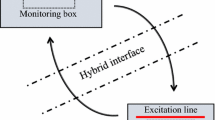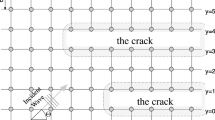Abstract
A theoretical model for ultrasonic wave scattering for geometrically irregular and imperfectly bonded interfaces is presented. Part I presents the stochastic interface characterization and a model for its mechanical response based on a micromechanics model of asperity contact. Part II uses this interface representation to write the well used “quasi-static” boundary conditions for scattering from a.flat imperfect interface1 directly on the irregular interface profile. The boundary conditions are then expanded in an asymptotic series in the roughness parameter (standard deviation of the surface height) which is small compared to wavelength. The slope of the profile must also be everywhere small. These equations are solved exactly for the zero-th and second order terms, which are the flat coherent solution and its' first coherent correction, and the first order term, which is the first term in the expansion for the incoherently scattered solution. Results for obliquely incident longitudinal and shear waves show a strong dependence on the roughness in both the coherent and incoherent reflected fields, but little if any dependence on the roughness in the transmitted fields. In particular, the reflected coherent fields show markedly increasing attenuation compared to the flat compliant interface with increasing roughness and increasing ultrasonic frequency, the latter result being in qualitative agreement with results for scattering from an inhomogeneous array of individual scatterers.2 There is evidence in the incoherent reflected fields for the existence of an incoherent leaky interface disturbance which manifests itself as a bulk incoherent shear wave at a scattering angle equal to the critical longitudinal angle. A coherent true interface wave is also supported by the rough interface which is shown to further attenuate the coherent reflected fields compared to the flat compliant interface solution.
Similar content being viewed by others
References
J. M. Baik and R. B. Thompson, Ultrasonic scattering from imperfect interfaces: A quasi-static model,J. Nondestr. Eval. 4:177–196 (1984).
J. H. Rose, Ultrasonic reflectivity of diffusion bonds,Rev. Prog. Quant. NDE 8B:1925–1931 (1989).
C. Pecorari, D. A. Mendelsohn, and L. Adler, Ultrasonic wave scattering from rough imperfect interfaces Part I: Stochastic interface models,J. Nondestr. Eval. 14: 109–116 (1995).
W. Kuperman and H. Schmidt, Self-consistent perturbation approach to rough surface scattering in stratified elastic media,J. Acoust. Soc. Am. 86:1511–1522 (1989).
K. Kendall and D. Tabor, An ultrasonic study of the area of contact between stationary and sliding surfaces,Proc. Roy. Soc. Lond. A323:321–340 (1971).
W. Kuperman, Coherent component of specular reflection and transmission for rough surface scattering using a Gaussian roughness spectrum,J. Acoust. Soc. Am. 58:365–370 (1975).
E. I. Thorsos and D. R. Jackson, The validity of the perturbation approximation for rough surface scattering using a Gaussian roughness spectrum,J. Acoust. Soc. Am. 86:261–277 (1989).
C. Pecorari, Scattering of Ultrasonic Waves from Rough Imperfect Solid-Solid Interfaces, PhD thesis, The Ohio State University (1992).
P. R. Nayak, Random process model of rough surface,J. Lubric. Technol. 93:398–407 (1971).
J. D. Achenbach, A. K. Gautesen, and H. McMaken,Ray Methods for Waves in Elastic Solids (Pitman Publishing Inc., Boston, 1982), p. 37.
T. H. Gray, F. J. Margetan, and R. B. Thompson, Ultrasonic NDE techniques for integrally fabricated rotors,Rev. Prog. QNDE (Plenum Press, New York, 1988),7B:1327–1334.
G. S. Murty, A theoretical model for the attenuation and dispersion of Stonely waves at the loosely bonded interface of elastic halfspaces,Phys. Earth and Plan. Int. 11:65–79 (1975).
Author information
Authors and Affiliations
Rights and permissions
About this article
Cite this article
Pecorari, C., Mendelsohn, D.A. & Adler, L. Ultrasonic wave scattering from rough, imperfect interfaces. Part II. Incoherent and coherent scattered fields. J Nondestruct Eval 14, 117–126 (1995). https://doi.org/10.1007/BF01183117
Received:
Revised:
Issue Date:
DOI: https://doi.org/10.1007/BF01183117




